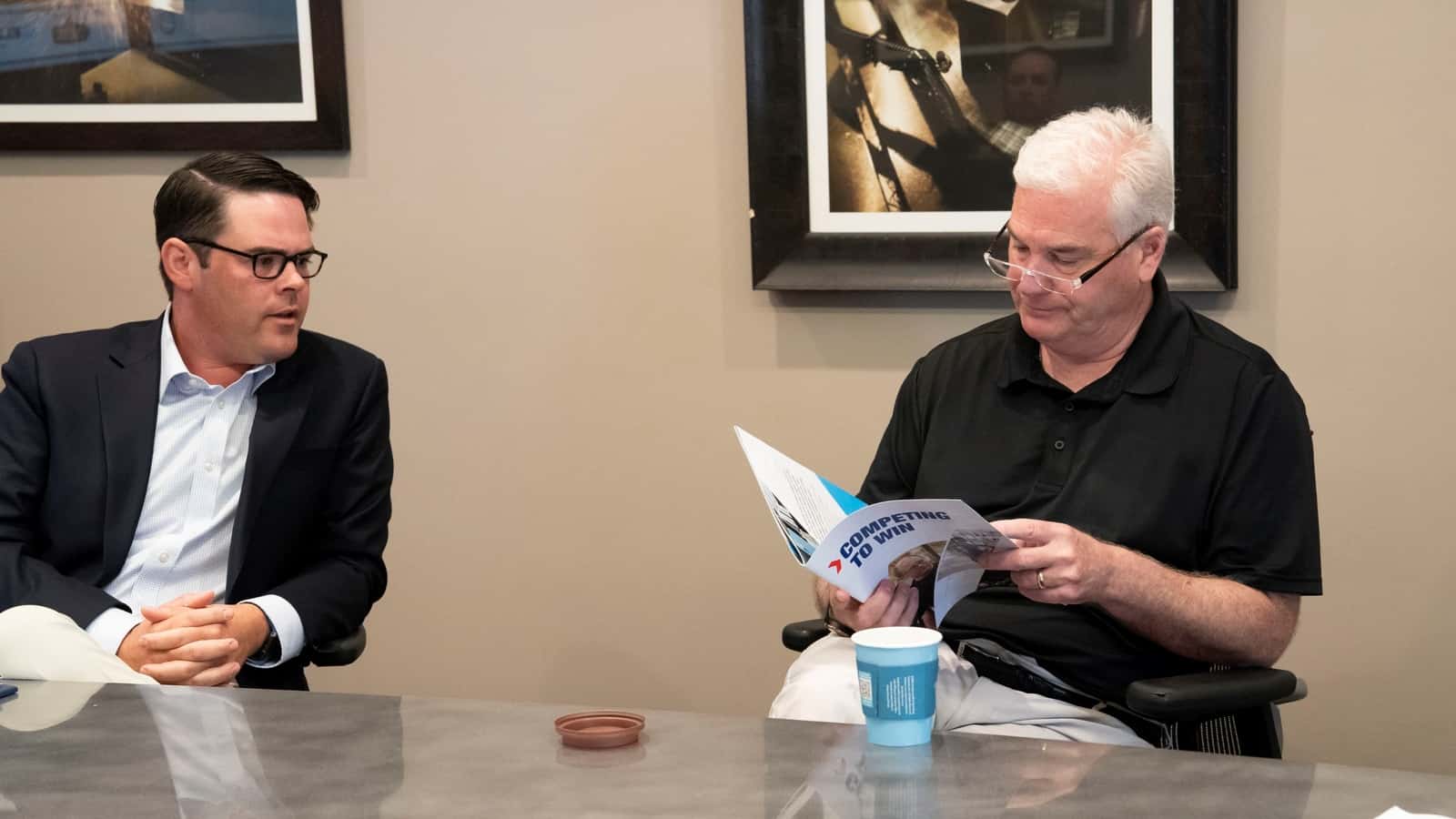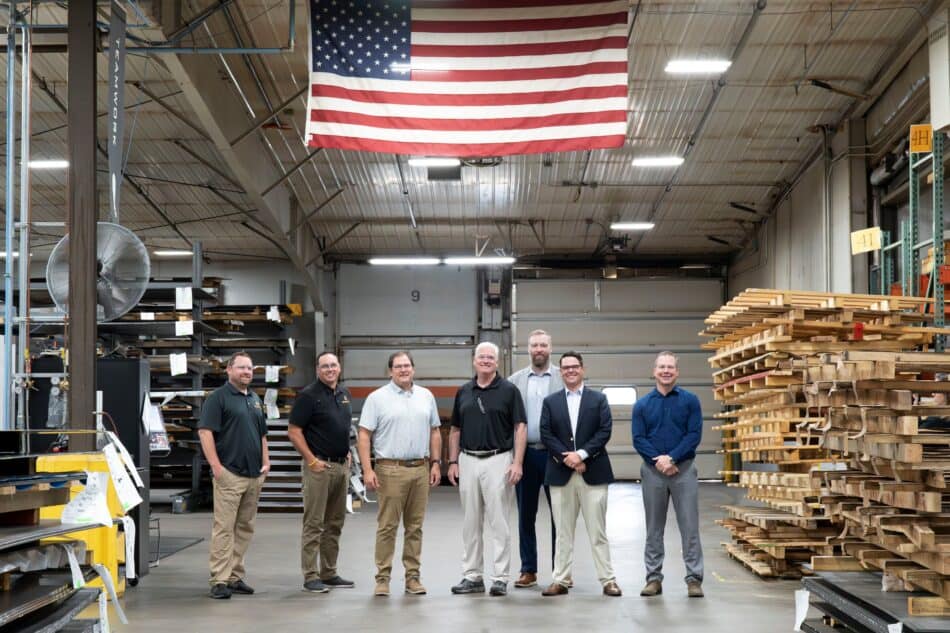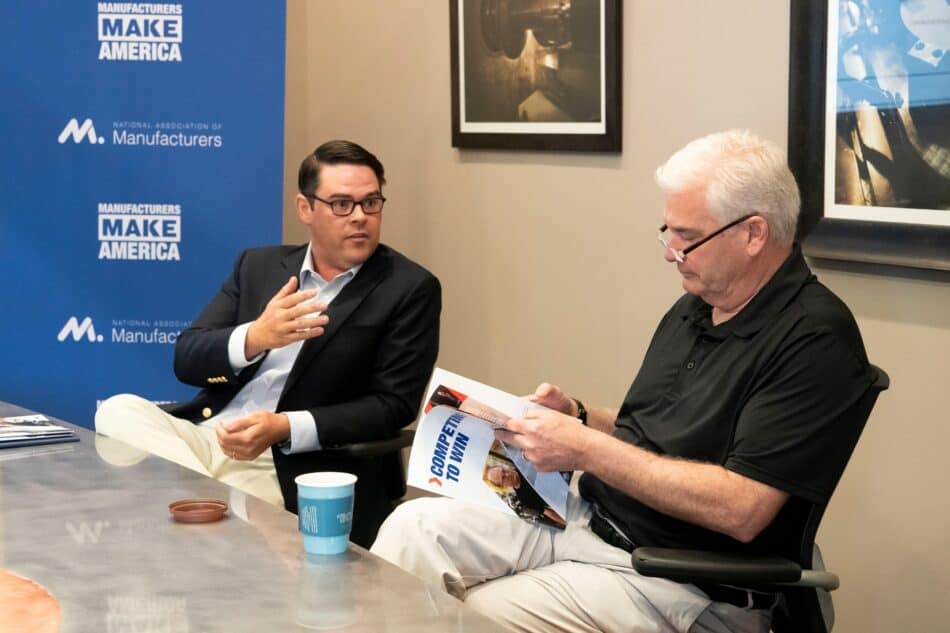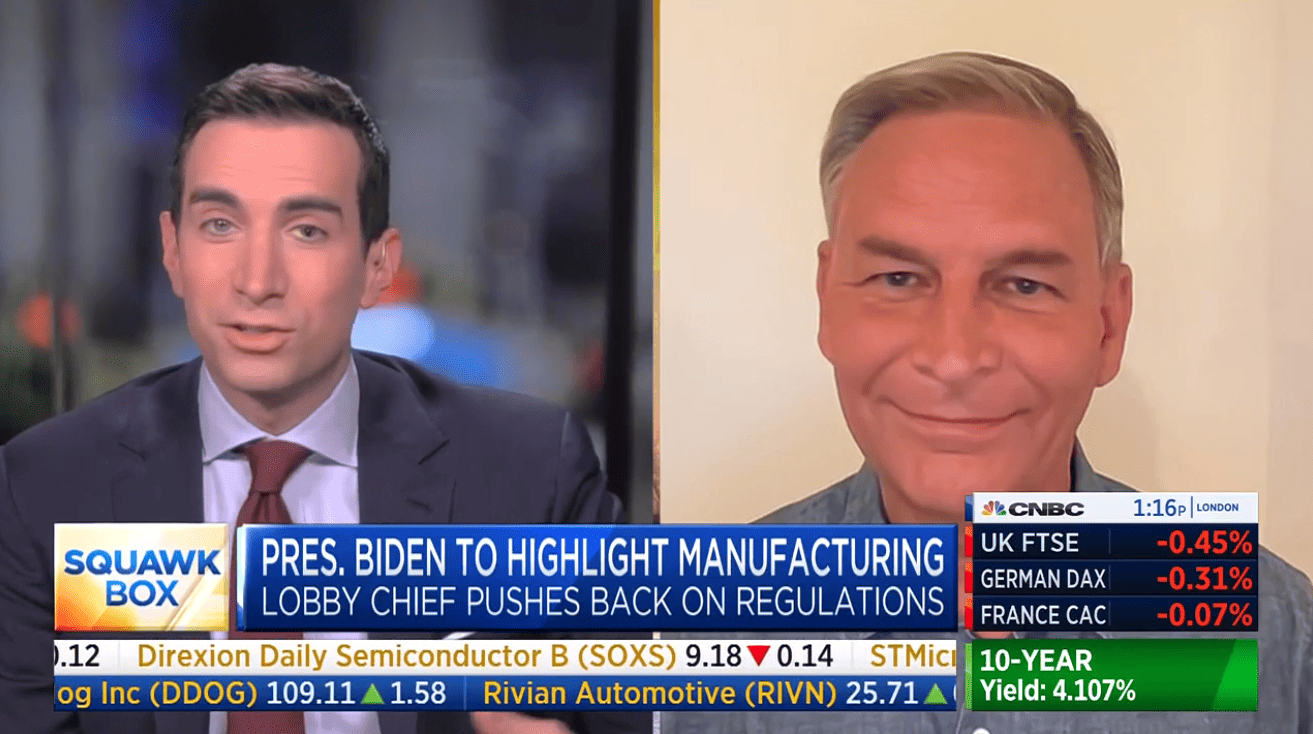NLRB Revives Troubling “Card Check” Process

Bringing back parts of a policy it dropped more than half a century ago, the National Labor Relations Board moved late last week to reinstate an abridged version of “card check,” according to Reuters (subscription).
What’s going on: In a “3-1 decision in a case involving building materials company Cemex Construction Materials,” the NLRB unveiled a new framework last Friday that revives the 1949 Joy Silk doctrine, which holds that “employers must bargain with unions unless they have a good-faith doubt that majority support exists.”
The background: The board had tossed out the doctrine in the early 1970s after the Supreme Court’s decision in NLRB v. Gissel Packing Co., in which the court held that “the NLRB could force employers to bargain with unions when they engage in misconduct so severe that any election would be tainted.”
- This new decision “could provide a major boost to unions by allowing them to represent workers in certain cases when a majority sign cards in support of unionizing, rather than going through the lengthy and often litigious election process.”
- Last week’s move also came a day after the board finalized a return to Obama-era regulations purportedly aimed at speeding up union elections.
Why it’s problematic: Card check—which the NAM has long opposed—is inherently unfair and insecure, and it strips employees of their right to secret ballots, said NAM Director of Infrastructure & Labor Policy Ben Siegrist.
- “The NLRB’s decision could create a glide path to force unionization on workers without the necessary safeguards of an election, and it runs counter to 50 years of precedent established by the Supreme Court,” he said. “Effectively, this action contradicts the rights all employees have in determining their own representation.”
Manufacturers Signal Concerns with Proposed DOL Overtime Rule
NAM: DOL’s proposed rule would inject new regulatory burdens and compliance costs to an industry already reeling from workforce shortages
Washington, D.C. – In response to the U.S. Department of Labor’s issuance today of a proposed rule altering the exemptions for overtime eligibility under the Fair Labor Standards Act, National Association of Manufacturers Managing Vice President of Policy Chris Netram issued the following statement:
“Manufacturers have spent the past several years adapting operations and personnel management resources to meet the evolving needs of their workforce in a post-pandemic environment, including through improved wages and benefits and productive workplace accommodations. The DOL’s proposed rule would inject new regulatory burdens and compliance costs to an industry already reeling from workforce shortages and an onslaught of other unbalanced regulations.
“Creating new regulatory processes and imposing additional mandatory costs will act as a drag on the sector and upend productive employer–employee relations. We look forward to expressing our concerns with this proposal directly to the DOL and administration leaders as the process moves forward.”
-NAM-
The National Association of Manufacturers is the largest manufacturing association in the United States, representing small and large manufacturers in every industrial sector and in all 50 states. Manufacturing employs nearly 13 million men and women, contributes $2.91 trillion to the U.S. economy annually and accounts for 55% of private-sector research and development. The NAM is the powerful voice of the manufacturing community and the leading advocate for a policy agenda that helps manufacturers compete in the global economy and create jobs across the United States. For more information about the NAM or to follow us on Twitter and Facebook, please visit www.nam.org.
NAM: Auto Worker Strike Would Harm Economy

As manufacturers continue to reel from supply chain disruptions, the NAM is calling for a swift resolution to forestall a potentially devastating United Auto Workers strike.
What’s going on: The UAW is negotiating a new labor agreement with important automotive manufacturers, as the current contract expires Sept. 14.
Why it’s important: The automotive manufacturing industry in the U.S. is one of the strongest and most productive in the world, and it significantly supports the health of the U.S. economy.
- A strike of 143,000 UAW members against Detroit’s “Big Three” auto manufacturers could mean an economic loss of $5.617 billion after just 10 full days, according to a new report by Anderson Economic Group.
- Nationwide, every $1 spent in the transportation-equipment sector causes another $1.59 to be spent elsewhere—for a total economic impact of $2.59, according to NAM calculations using 2021 IMPLAN data.
- In 2022, the total value-added in motor vehicles and parts in the U.S. was $171.6 billion, according to the Bureau of Economic Analysis.
State-level impact: In 2019, a 42-day auto-worker strike at one of the Detroit manufacturers “sent the state of Michigan into a one-quarter recession” and resulted in an economic loss of $4.2 billion, according to reporting by The Detroit News.
- As of 2021, the latest year for which this data is available, Michigan’s total output from motor vehicles, bodies and trailers, and parts manufacturing was $37.5 billion, accounting for 37% of total manufacturing output in the state, according to the BEA.
- At the same time, Michigan had 175,745 full- and part-time employees in the sector, or 28.7% of all manufacturing employees in the state.
- Meanwhile, the total output of Illinois’ auto sector accounted for 19.3% of the state’s total manufacturing output, while employment came to 23.6% of the state’s manufacturing employees.
Undermining manufacturing in the U.S.: “Manufacturers in America, especially in the automotive sector, operate in an integrated supply chain, which means that small and medium-sized manufacturers around the country—in union and non-union shops—would endure the consequences of a stoppage. As we continue to emerge from the global pandemic and work to get our economy on a sustainable track, a strike would be devastating for working families across our country,” said NAM President and CEO Jay Timmons.
- “President Biden has prioritized strengthening manufacturing in America, but that will be quickly undermined if a strike occurs. The administration should be encouraging a swift resolution to avoid ripple effects throughout the broader manufacturing economy and in communities from coast to coast.”
Rep. Emmer, NAM Visit Glenn Metalcraft

Workforce challenges and the regulatory onslaught against manufacturers were some of the key topics covered during a recent NAM meeting with House Majority Whip Tom Emmer (R-MN) in Princeton, Minnesota.
What’s going on: Emmer met NAM leadership last Monday for a facility tour of heavy-gauge metal spinnings company Glenn Metalcraft, led by its president and CEO, Joe Glenn.
- On the walkthrough, Emmer got to see and hear the impact of the current legislative deluge hitting manufacturers.
- “My visit to Glenn Metalcraft demonstrated the need to address the regulatory state overwhelming manufacturers in the heartland,” Emmer said. “Small and medium-sized manufacturers are working hard to grow their businesses and increase compensation for employees, but those efforts are undermined by new regulations and the lack of permanent, competitive tax policies to promote research and development and capital investment.”
“Fighting to thrive”: Glenn spoke candidly about his and other manufacturers’ current struggles with the excessive mandates handed down by federal agencies.
- “Manufacturers across the country are fighting to thrive under the weight of an increasing number of unbalanced and often unfeasible regulations from agencies across the federal government—all amid an uncertain economic environment,” Glenn said before thanking Emmer for “giving us a voice.”
- The majority of manufacturers—more than 63%—say they now spend over 2,000 hours a year complying with federal mandates, according to the NAM’s Q2 2023 Manufacturers’ Outlook Survey.
Tax treatment of R&D: Emmer’s support of the American Innovation and R&D Competitiveness Act—which would permanently restore immediate research-and-development expensing for small businesses for 2022 and all subsequent years—has been instrumental in the legislation’s progress, NAM Managing Vice President of Communications and Public Affairs Jamie Hennigan told the whip. Now we just need to move the issue forward, he added.
- Glenn underscored the importance of full expensing when he told Emmer that it had helped his company open new facilities.
- Emmer agreed on the necessity of competitive tax provisions and said he, too, wanted to see them reinstated.
A persistent problem: NAM leaders and Glenn also addressed another ongoing challenge for manufacturers in their discussion with Emmer: the acute shortage of skilled workers.
- The difficulty of attracting and retaining skilled workers has consistently ranked among the top problems cited by manufacturers in the Outlook Survey, as Hennigan pointed out.
The last word: “Manufacturers have made it clear that the [Biden] administration’s regulatory agenda could easily derail manufacturing’s recent success,” NAM President and CEO Jay Timmons said in a statement after the visit.
- “Glenn Metalcraft and so many others are forced to make tough decisions as agencies issue unbalanced regulations that threaten our sector’s ability to grow and compete.”
- “The positive effects of tax reform, the Bipartisan Infrastructure Law and the CHIPS and Science Act are all being undermined by the growing regulatory burden, and I want to thank Whip Emmer for spotlighting this threat in his home state of Minnesota.”
House Majority Whip Emmer, NAM Spotlight Cost of Regulations and Policies to Boost Manufacturing
Princeton, MN – The National Association of Manufacturers hosted House Majority Whip Tom Emmer (R-MN) at Glenn Metalcraft for a facility tour on Monday to discuss the impact of the current regulatory burden manufacturers are facing across federal agencies.

Leaders also discussed manufacturers’ policy priorities as outlined in the latest version of “Competing to Win,” the NAM’s comprehensive blueprint to bolster manufacturers’ competitiveness.

“My visit to Glenn Metalcraft demonstrated the need to address the regulatory state overwhelming manufacturers in the heartland. Small and medium-sized manufacturers are working hard to grow their businesses and increase compensation for employees, but those efforts are undermined by new regulations and the lack of permanent, competitive tax policies to promote research and development and capital investment,” said House Majority Whip Tom Emmer. “I want to thank the National Association of Manufacturers and Glenn Metalcraft for providing insight that will guide my work in Congress.”
“Manufacturers across the country are fighting to thrive under the weight of an increasing number of unbalanced and often unfeasible regulations from agencies across the federal government—all amid an uncertain economic environment,” said Glenn Metalcraft President and CEO Joe Glenn. “Glenn Metalcraft would like to thank Whip Emmer and the National Association of Manufacturers for giving us a voice and calling attention to this issue.”
“Manufacturers are struggling to navigate substantial regulations from Washington on top of the deluge of new laws from St. Paul. We appreciate Whip Emmer for expanding our state-level efforts on the national stage,” said Minnesota Chamber President and CEO Doug Loon. “The National Association of Manufacturers is an excellent partner in championing policies for businesses to grow and compete globally. We appreciate their efforts with the Biden administration and Congress to hold agencies accountable and deliver sensible regulations.”
“The barrage of federal regulations from Washington has created serious concern across our industry, with manufacturers reporting that it’s standing in the way of job creation, investment and wage growth. Manufacturers have made it clear that the administration’s regulatory agenda could easily derail manufacturing’s recent success. Glenn Metalcraft and so many others are forced to make tough decisions as agencies issue unbalanced regulations that threaten our sector’s ability to grow and compete,” said NAM President and CEO Jay Timmons. “The positive effects of tax reform, the Bipartisan Infrastructure Law and the CHIPS and Science Act are all being undermined by the growing regulatory burden, and I want to thank Whip Emmer for spotlighting this threat in his home state of Minnesota.”
Background: Recently, the NAM, members of the NAM’s Council of Manufacturing Associations and Conference of State Manufacturers Associations launched Manufacturers for Sensible Regulations, a coalition addressing the impact of the current regulatory onslaught coming from federal agencies.
According to the NAM’s Q2 2023 Manufacturers’ Outlook Survey, more than 63% of manufacturers report spending more than 2,000 hours per year complying with federal regulations, while more than 17% of manufacturers report spending more than 10,000 hours. The NAM survey also highlighted that only 67% of manufacturers are positive about their own company’s outlook, the lowest percentage since Q3 2019. It shows the consequences of regulations: If the regulatory burden on manufacturers decreased, 65% of manufacturers would purchase more capital equipment, and more than 46% would increase compensation.
-NAM-
The National Association of Manufacturers is the largest manufacturing association in the United States, representing small and large manufacturers in every industrial sector and in all 50 states. Manufacturing employs nearly 13 million men and women, contributes $2.90 trillion to the U.S. economy annually and accounts for 55% of private-sector research and development. The NAM is the powerful voice of the manufacturing community and the leading advocate for a policy agenda that helps manufacturers compete in the global economy and create jobs across the United States. For more information about the NAM or to follow us on Twitter and Facebook, please visit www.nam.org.
Timmons on Regulations: Make Them “Sensible and Achievable”

“There are good things coming from [the Biden] administration”—including the CHIPS and Science Act and historic infrastructure investment—but there are also several trends that spell trouble for manufacturing in the U.S., NAM President and CEO Jay Timmons said on CNBC’s “Squawk Box” on Monday.
A three-fold issue: “On the one hand we have a manufacturing strategy that Congress and the administration have been putting forward, which is … to prioritize growing manufacturing here in the United States,” Timmons told CNBC’s Andrew Ross Sorkin.
- “But … you’re compounding that with three things. One is the [number] of regulations coming down. … [Two is] slow permitting, which is making it difficult for manufacturers to build those facilities they’re willing to invest in. Thirdly, [in] some of the provisions that have been enacted, there’s been confusing guidance or no guidance when it comes to accessing the funds and credits that are available for manufacturing. All three of those things together are making it very difficult for manufacturers to compete and succeed in our global economy.”
- The NAM is engaging on approximately 100 different regulations coming from 30 different government agencies, Timmons added.
Make regulation smart, achievable: Manufacturers are in favor of reasonable regulations that enable them to succeed, Timmons continued. “We’re not saying ‘No regulation’; we’ve never said that. What we’re saying is, ‘Let’s make these regulations essential, smart and achievable.’”
- He cited the National Highway Traffic Safety Administration’s new Corporate Average Fuel Economy Standards—which the NAM has told the administration are unworkably stringent and will drive up costs for manufacturers—as well as the Environmental Protection Agency’s new standards for ambient air quality, which a NAM-commissioned study found would threaten billions in economic activity and cost hundreds of thousands of jobs.
NAM in action: The NAM recently joined forces with members of its Council of Manufacturing Associations and the Conference of State Manufacturing Associations to launch Manufacturers for Sensible Regulations, a coalition created to address the negative effects of these federal regulations.
Amp Up Your Advocacy with the NAM’s Help

Ever wondered how best to contact your members of Congress? Or invite them on a tour of your facility? The NAM’s advocacy division, which helps manufacturers express their priorities to D.C. decision-makers, recently released a new and important resource: a suite of toolkits for different advocacy activities, including facility tours and more.
Congressional contact: There is an art to contacting Congress, as the NAM’s advocacy team will tell you. Their “Engaging Congress” toolkit provides simple, easy to remember rules for all types of communication, as well as sample letters and phone messages.
- By email: A few key tips include using a clear subject line, making sure that you identify yourself as a constituent and providing strong facts and data. And don’t forget to make it personal—the congressional office should understand that you yourself are harmed (or benefitted) by the policy in question.
- By phone: The advice for phone calls is similar—make sure you identify yourself as a constituent and a manufacturer, and that you have a clear request for the congressional staffer answering your call. Personal details matter in this format as well.
Lastly, consider attending town halls or other events hosted by your members of Congress, where you can also voice your opinions and connect with their offices.
Facility visits: Another way to make an impact on your representatives is to invite them over to your place. Hosting a facility tour can seem daunting or complicated, but the NAM’s toolkit breaks it down into eight easy steps. This collection of advice from the experts includes the following:
- How to create a guest list, send invitations and coordinate with congressional office staff
- How to prepare for media participation and craft a CEO message
- How to organize the tour itself, from preparing the premises to greeting the lawmaker to providing safety equipment and more
- How to show the visitors around while dropping key talking points into the conversation
That’s only a snapshot of this helpful toolkit, which includes many hints that you may not ever have considered—such as designating a notetaker to join the tour and keep a record of it.
Become an ambassador: If you are interested in making advocacy one of your missions, consider becoming an NAM Ambassador. Ambassadors share their stories with the media and policymakers, take public positions on key manufacturing issues, publish op-eds, host elected officials at their facilities and much more.
Check it out: Explore the whole toolkit and learn how you can become an effective public advocate for your company, your industry and the American economy.
SEC Finalizes Cybersecurity Disclosures Rule

After an aggressive campaign by the NAM, the U.S. Securities and Exchange Commission has scaled back a damaging cybersecurity proposal that would have been deeply problematic for manufacturers. Yet, the final regulations still impose compliance burdens on publicly traded companies. Here’s what manufacturers can expect now that the rule is finalized.
The background: Last year, the SEC proposed a new set of cybersecurity disclosure requirements for public companies. The centerpiece of the rule was a mandate to disclose cybersecurity incidents to the public within four days. The proposal also would have required detailed reporting on companies’ policies and procedures for responding to cybersecurity threats.
The problem: Requiring detailed public disclosures about cybersecurity incidents and processes could provide a roadmap to potential hackers, and sharing information about ongoing incidents could compromise efforts to stop an attack.
The NAM response: The NAM urged the SEC to make commonsense adjustments to protect manufacturers from attacks and give companies the flexibility to respond to cybersecurity incidents appropriately.
The result: The final rule is more tailored than the initial proposal, reducing the risk that companies will be forced to expose sensitive information. But its requirements still impose new compliance burdens on manufacturers.
Incident reports: The rule still requires companies to report cybersecurity incidents publicly within four days, but companies will be able to request that the attorney general grant a 30-day extension to protect public safety or national security—a top priority for the NAM. The extension could be lengthened by an additional 30 days (for public safety) or 90 days (for national security) if warranted.
- Thanks to the NAM’s intervention, the SEC will require the disclosure of only limited information about an attack’s circumstances and impact, whereas the original proposal would have forced companies to disclose extensive details, including potentially sensitive data.
- In addition, a provision requiring companies to track, aggregate and disclose the impact of minor cybersecurity incidents—which the NAM opposed—was struck from the final rule.
Risk management and governance: Companies will be required to disclose information on cybersecurity oversight by their board and management, as well as how cybersecurity is incorporated into their overall risk management strategy.
- These disclosures must include “sufficient detail for a reasonable investor to understand” a company’s cybersecurity risk management—but will no longer include information on a company’s specific prevention and detection activities.
- A provision effectively requiring companies to have a cyber expert on their board, which the NAM strongly opposed, was not included in the final rule.
Our take: “The NAM is committed to a smart, flexible disclosure approach that ensures manufacturers—and their customers and shareholders—can stay protected from cybersecurity threats,” said NAM Senior Director of Tax and Domestic Economic Policy Charles Crain.
- “Manufacturers were glad to see that the SEC made some adjustments to its rule, but more must be done. The SEC and the Department of Justice must grant companies the flexibility to delay incident reporting to prevent threats to public safety and national security.”
Get protected: Every manufacturer should have the tools they need to protect themselves against cyberattacks. Check out NAM Cyber Cover—an exclusive cybersecurity and risk mitigation program for NAM member companies and organizations.
Manufacturers: DOE Gas Stove Rules Revision Is Step in Right Direction
Washington, D.C. – Following the announcement that the U.S. Department of Energy has modified its proposed energy-efficiency rules for gas stoves to be less restrictive, National Association of Manufacturers Managing Vice President of Policy Chris Netram released the following statement:
“Manufacturers depend on regulatory clarity and certainty. Throughout the year, the Department of Energy has proposed an unprecedented slew of regulations, and many were aimed at home appliances. The DOE is now taking steps toward a solution that is less likely to raise production costs significantly for manufacturers, and less likely to reduce the available features, performance and affordability for consumers.
“Manufacturers remain committed to working with the DOE and all federal agencies to ensure that proposed rules and regulations are practical, feasible and environmentally sound without harming our ability to create well-paying jobs and investment in the United States.”
The NAM, along with members of the Manufacturers for Sensible Regulations, have been highlighting the negative impact of unbalanced regulations on manufacturers, noting the agency’s own data showed that 96% of existing gas stove models currently available would not comply.
Background: According to the NAM’s Q2 2023 Manufacturers’ Outlook Survey, more than 63% of manufacturers report spending more than 2,000 hours per year complying with federal regulations, while more than 17% of manufacturers report spending more than 10,000 hours. The NAM survey also stressed that only 67% of manufacturers are positive about their own company’s outlook, the lowest since Q3 2019. It shows the consequences of regulations: If the regulatory burden on manufacturers decreased, 65% of manufacturers would purchase more capital equipment, and more than 46% would increase compensation.
-NAM-
The National Association of Manufacturers is the largest manufacturing association in the United States, representing small and large manufacturers in every industrial sector and in all 50 states. Manufacturing employs nearly 13 million men and women, contributes $2.91 trillion to the U.S. economy annually and accounts for 55% of private-sector research and development. The NAM is the powerful voice of the manufacturing community and the leading advocate for a policy agenda that helps manufacturers compete in the global economy and create jobs across the United States. For more information about the NAM or to follow us on Twitter and Facebook, please visit www.nam.org.
NAM Pushes Back on New Emissions Standards

The Biden administration’s new fuel-economy standards are too aggressive and add conflicting mandates to on-the-books regulations, the NAM said Friday.
What’s going on: The Department of Transportation’s National Highway Traffic Safety Administration issued a proposal calling for a revision of current Corporate Average Fuel Economy standards for cars and light-duty trucks—to a fleet average of 58 miles per gallon by 2032.
- The draft rules are a complement to regulations released “in April that are the strictest on record and push automakers to make the majority of their sales electric vehicles,” reports Auto Dealer Today.
Why it’s problematic: “Auto manufacturers have been making historic investments to ensure that electric vehicles will have a growing place on America’s roads,” said NAM President and CEO Jay Timmons. “However, the NAM has concerns over the three different sets of standards governing light- and medium-duty vehicles. For instance, the Environmental Protection Agency’s proposed regulation on light- and medium-duty vehicles would require 67% of new manufactured vehicles to be battery electric by 2032 and is too aggressive.”
- Some of the rules that have been put forth recently by federal and state agencies conflict with one another, and some—particularly those released by the EPA—would increase the cost of both manufacturing and purchasing vehicles.
- “In addition, the federal government should not dictate the vehicle choices offered to consumers,” Timmons pointed out. “The administration should allow the market and consumers to grow the number of electric vehicles, rather than depending on a single technology to meet this goal.”
What can be done: “[T]hese regulations should be harmonized to create a single unified standard for vehicle emissions, so manufacturers do not have to navigate three often-conflicting targets, which raise costs for manufacturers and consumers,” Timmons continued.
What we’re doing: In June, the NAM and members of the NAM’s Council of Manufacturing Associations and Conference of State Manufacturing Associations launched Manufacturers for Sensible Regulations, a coalition aimed at addressing the negative effects of the multiple, often contradictory regulations being handed down by federal agencies.
